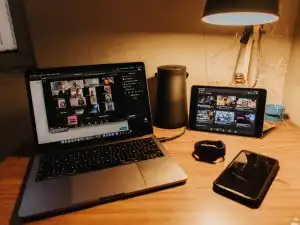As we settle into working from home, most of our workplace interactions are taking place virtually. I wrote before about the importance of setting up your work space at home in a way that maximizes productivity, but it’s not just the physical space that counts. Setting up your virtual workspace is just as important, especially when projects call for productivity as a team. Here are some tips for improving your virtual meetings and collaborations.
Setting the Physical Stage
This article from Forbes on professional best practices for virtual meetings emphasizes the importance of considering your physical surroundings in advance. Find a quiet room, preferably with carpet, to prevent a hollow, echoing sound distracting from your speech. Set up a laptop, not a phone, at eye level on your desk. (You can use a shoebox to lift up the laptop if you need it.) This way, you’ll present a stable image of your face in meetings, the best possible approximation to your physical presence. Plus, your hands will be free to take notes if needed. Next, turn on the webcam and check out what your coworkers will be seeing in your background. As this New York Times article points out, a pile of laundry in the corner behind you won’t help your professional image. Finally, make sure you have high quality lighting you can adjust, based on the time of day. This article has some suggestions to improve the lighting by your space.
Check the Tech
Before you need to join a meeting, preferably well in advance, make sure you’re familiar with whatever platform and software you’ll need to use to participate. This Harvard Business Review article encourages workplace leaders to set up meetings with video to enhance participation, but there should also be an audio dial-in option for those with lower Internet speeds. If you’re an organizer, make sure you offer that option. If you’re a participant, try to determine in advance which option you’ll use. This article also points out that you may need to grant explicit permissions to a new platform the first time you’re using it for access to the webcam, microphone, documents, etc. Try to familiarize yourself with the important features of the platform before you’re being asked to use them in the meeting itself. Finally, get help if you need it! This article has some great suggestions for tackling common tech issues you may encounter.
Participation Trophies for All

In a virtual meeting, there’s less motivation to engage and more temptation to slack off. It’s largely up to meeting organizers to encourage the team to stay present and focused. If you’re leading a meeting, this article suggests that you appoint a meeting facilitator. In the absence of the usual nonverbal cues we rely on in conversation, a facilitator can help track and respond to participants raising their hand, participants being left out of the conversation, and the meeting agenda. Speaking of which, meeting organizers can use the collaborative tasks on Pyrus to make the meeting agenda clear in advance and delegate clear roles to team members. This article encourages group leaders to ensure that every meeting participant knows their role and understands the importance of their participation in the conversation. As for the participants, try to turn off all notifications on the device you’re using to join the meeting. Minimizing outside distractions will help the meeting run more effectively.
Uncommon Courtesy
Even with all meeting participants eager to contribute, with the tech working great and a fantastic set up, virtual meetings will likely still take a lot of getting used to. They’re part of our new normal. They won’t feel normal right away. In addition to planning for virtual success, find ways to make meetings feel closer to in person interactions. For instance, this article recommends directing your gaze towards the camera on your device whenever possible instead of just staring at the faces on your screen. That way, other participants in your meeting will get more of a sense that you’re looking at them and paying attention, whether you’re talking or listening to them. Additionally, remind yourself that you’re at work by dressing professionally. I discussed this strategy in my earlier article on timing productivity. If you’re in a noisy space, you may also want to mute yourself when you’re not speaking. Other meeting participants might be a bit thrown off by the sound of children sharing in your background… or arguing, whatever the case may be.
Questions? Comments? Concerns?
Finally, when you’ve wrapped up a virtual meeting, gather feedback. If you’re an organizer, encourage meeting participants to share what went well and what presented a challenge. If you were a participant, reach out to the organizers with any constructive feedback you have on your mind. As this article suggests, keeping feedback flowing between coworkers will help improve the productivity of virtual meetings over time.
Speaking of which, let me know if this article is helpful for you! As I continue writing, I’d appreciate the feedback on which topics feel most relevant so I can keep sharing useful tips to help make your workdays more productive. Happy meeting!